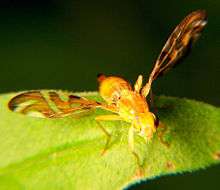Strauzia longipennis
Strauzia longipennis is a large species of tephritid fruit fly known by the common name sunflower maggot fly. It is a minor pest being a plant miner of sunflowers and related plants, damage within flower receptacle from larval feeding on spongy tissue is usually light.
| Strauzia longipennis | |
|---|---|
 | |
| Scientific classification | |
| Kingdom: | |
| Phylum: | |
| Class: | |
| Order: | |
| Family: | |
| Subfamily: | |
| Genus: | |
| Species: | S. longipennis |
| Binomial name | |
| Strauzia longipennis ([[[Christian Rudolph Wilhelm Wiedemann|Wiedemann]], 1830]) | |
| Synonyms | |
| |
Adults are about 6 mm long and a wing length of approximately 7 mm. (reasonably large for a Tephritid) The body is creamy-white and the wings have a mottled yellowish-brown appearance, with distinct F shaped marking near the wing tips. The larvae are yellowish-white in colour reaching a length of about 5 mm and spend around 30 days feeding within the host plant before overwintering in the soil as pupae. Adults are found from mid-July through to August.
There are two other species of Tephritid fly known as Sunflower Maggot, these are Gymnocarena diffusa which feeds on stem pith and Neotephritis finalis which feeds on the sunflower seeds.
External links
| Wikimedia Commons has media related to Strauzia longipennis. |